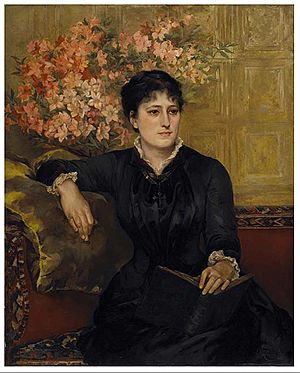Henrietta Montalba facts for kids
Quick facts for kids
Henrietta Montalba
|
|
|---|---|

Henrietta Montalba painted by The Princess Louise in 1882
|
|
| Born |
Henrietta Mary Ann Skerrett Montalba
8 April 1848 England
|
| Died | 8 April 1893 (aged 45) |
| Nationality | British |
| Known for | Sculpture |
Henrietta Montalba (born April 8, 1848 – died September 14, 1893) was a talented British sculptor. She came from a famous family of artists. She learned art at the Royal College of Art. A classmate was Princess Louise, Duchess of Argyll, who later became a real princess! Princess Louise even painted a picture of Henrietta, which you can see at the National Gallery of Canada.
Henrietta showed her art for the first time at the Royal Academy of Arts in 1876. Her sculptures were often displayed at the Grosvenor Gallery in London. She stayed close to her family, often living in their home in Venice, Italy. Henrietta passed away in Venice on September 14, 1893. She was buried near her father in the island cemetery of San Michele. One of her famous sculptures, called Boy Catching a Crab, is now at The Victoria and Albert Museum.
Contents
Early Life and Art Studies
Henrietta Montalba was born on April 8, 1848. She was the fifth child in her family. Her parents were Anthony Rubens Montalba and Emeline Davies. All of Henrietta's sisters also became successful artists.
She was born in London, England. Her father was a gentleman. In 1871, the census showed her father living with his four artist daughters in London. Henrietta first studied art at what is now the Royal College of Art in London. Later, she went to the Accademia di Belle Arti di Venezia in Venice, Italy. She also learned from Jules Dalou, a famous French sculptor, when he lived in London.
Her Artistic Career
Henrietta Montalba first showed her artwork at the Royal Academy of Arts in 1876. Her sculptures were often seen at important galleries. These included the Grosvenor Gallery and the New Gallery in London.
She mostly created busts, which are sculptures of a person's head and shoulders. Some of her busts were made from beautiful marble. Others were made from bronze. Many of her works were made from terra cotta, which is a type of baked clay. One famous terra cotta bust was of the writer Robert Browning.
Other notable works included "A Dalecarlian Peasant Woman." She also made "The Raven," which showed a raven sitting on a bust of Pallas. This sculpture was inspired by a poem by Edgar Allan Poe. Her last big sculpture was a life-size bronze figure. It was called "A Venetian Boy Catching a Crab." This piece was shown at the Royal Academy in 1893. It was also displayed at the World's Columbian Exposition in Chicago that same year.
Her marble bust of Richard Burchett is also important. He was the headmaster of the South Kensington Schools where she studied. This sculpture is now at the new Royal Academy of Arts building.
Friendship with Royalty
Henrietta was good friends with Princess Louise, Duchess of Argyll. They were classmates at art school. Princess Louise painted a portrait of Henrietta. She gave this painting to the Royal Canadian Academy of Arts in Ottawa. Today, it is part of the collection at the National Gallery of Canada.
Both Henrietta and her sister Clara spent time with Princess Louise in Canada. They painted landscapes together. Henrietta was very close to her family. She often lived with them in Venice. They also traveled together to places like Italy and Sweden. Besides her art skills, Henrietta was also very good at learning languages.
Later Life and Legacy
In 1892, Henrietta's health started to get worse. After being sick for a while, she passed away in Venice on September 14, 1893. She was buried near her father in the cemetery of Isola di San Michele.
One of her sculptures, the bronze called Boy Catching a Crab, is on display. You can see it at The Victoria and Albert Museum in London. Her marble bust of Richard Burchett is also still displayed. It is at the new Darwin Building of the Royal College of Art in London.
See also

